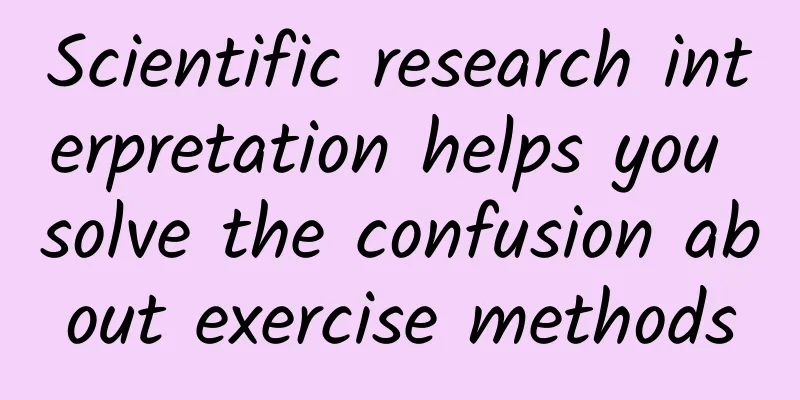Scientific research interpretation helps you solve the confusion about exercise methods

|
In today's society, the concept of increasing physical activity has been deeply rooted in people's minds. Whether from children to young adults, from preventing the occurrence of chronic diseases to secondary prevention of diseases, rational and scientific exercise has been recommended by many scholars and clinical workers as one of the important prescriptions. As early as 2008, the American Heart Association emphasized in its physical activity guidelines that healthy adults should accumulate at least 150 minutes of moderate-intensity activity or 75 minutes of high-intensity exercise per week to get the most benefit from exercise. But for office workers in the "996" model, the huge pressure at work makes it difficult for them to spare half an hour for moderate-intensity exercise, and even low-intensity exercise may be difficult to achieve. Therefore, the updated guidelines have added content about the benefits of at least 10 minutes of activity each time . The concept of "small amounts and multiple times" has gradually been accepted by more and more people and better implemented. However, whether this way of exercise has a direct effect on reducing mortality, and whether it emphasizes small amounts and multiple times or the duration of each exercise can benefit people more, the current evidence support is still very limited, and it always causes waves of topics and controversies. Today, the editor will take you to understand how a large sample study evaluates this controversy. This is a study published in the American Journal of Cardiology. The researchers selected data from people over 40 years old who participated in the Health and Nutrition Survey between 2003 and 2006, tracked the subjects' physical activity and activity methods, and measured the mortality rate of the population in 2011. A total of 4,840 people participated and completed the entire experiment. The researchers asked everyone to wear a belt containing a uniaxial accelerometer every day to record their daily activities, and set the accelerator shaft speed to 760 revolutions per minute to indicate that medium to high intensity activities had been achieved. After about 6.6 years of follow-up, there were 700 deaths in these people. After adjusting for confounding factors, correlation analysis found that the more moderate to high intensity exercise, the lower the mortality rate, which was not directly related to exercise for a specific period of time or a small amount of exercise multiple times. However, when the total amount of moderate to high intensity exercise is insufficient, a specific long-term exercise method will benefit more than a small amount of exercise for 5 or 10 minutes each time. New findings from the study In the above study, the main purpose was to understand whether increasing the number of medium to high intensity activities and reducing the duration of each exercise can also reduce the endpoint indicator, namely mortality. Through long-term follow-up records, analysis found that as long as the amount of exercise is sufficient, each short time, but multiple times a day of medium to high intensity exercise can indeed reduce mortality, and the effect is not significantly different from exercising for a specific period of time. Therefore, the positive significance of scientific exercise is further clarified. Medium to high intensity exercise training does have the effect of reducing the risk of death, and it has nothing to do with how to exercise. In other words, medium to high intensity activities divided into 3 times a day, 10 minutes each time and concentrated for 30 minutes can effectively reduce the risk of death.
The findings of this result can guide the formulation of physical activity guidelines and provide more options for exercise methods. At the same time, this study also found that as long as the total amount of exercise meets the standard, regardless of the number and time, it can bring health benefits. When office workers do not have enough time and cannot achieve the goal of 150 minutes of exercise per week, it is recommended to choose 2-3 long-term medium to high intensity exercises, which may benefit more. This also gives us physical therapists some warnings. When making recommendations to patients, we can give more flexible exercise prescription suggestions based on their lifestyle and exercise habits, so as to help them more easily achieve the goal of 150 minutes of medium to high intensity exercise per week. This more flexible approach is easier to implement for those who have little activity and are at great risk of chronic diseases, and it will help them maintain good exercise habits for life. The popular science content of this platform has been funded by the China Association for Science and Technology's Science Popularization Department's 2022 National Science Literacy Action Project "National Society Science Popularization Capacity Improvement Project-Rehabilitation Science Popularization Service Capacity Improvement Action Plan" |
<<: Can I not exercise if I have a meniscus injury?
>>: Rehabilitation exercises are also needed before and after lumbar spine surgery
Recommend
Why is black rice black? Who is suitable to drink black rice porridge?
I guess many of you will have this question? Why ...
What should you pay attention to after doing the postpartum sweat steaming?
Nowadays, many people do sweat steaming, which is...
A hard lump on the vulva hurts
A healthy body can enable us to have more control...
How many days is the confinement period after miscarriage?
The time of confinement after miscarriage is the ...
How to tell whether a turtle is wild or farmed? The difference between wild and farmed turtles
Turtle, also known as turtle, is often called &qu...
Does your Parkinson's disease need surgery? Mainly judge from these 4 aspects
Patients often consult about Parkinson's surg...
How do women protect their cervix?
Women should pay attention to their physical heal...
Why can't you wash your hair during menstruation?
In daily life, women’s bodies are not as good as ...
What should pregnant women do if they eat grass jelly?
Nowadays, some pregnant women like to drink some ...
Can pregnant women take glucose?
Pregnant women can inject glucose when they feel ...
How many days to recover from ectopic pregnancy surgery
As we all know, many women feel confused when dea...
What should patients undergoing allogeneic hematopoietic stem cell transplantation pay attention to in their diet while in the sterile cabin? Can they eat fruit?
Author: Yan Xia, deputy chief nurse, Peking Unive...
What are the characteristics of sesame oil flavor? Nutritional components of sesame oil
Sesame, also known as sesame and sesame, is a see...
What are the methods of breast augmentation surgery?
Breast augmentation is a common choice for many w...
What should I do if sanitary napkins cause inflammation?
For adult women, sanitary napkins are daily neces...









